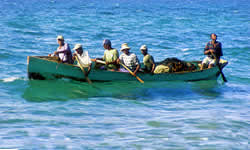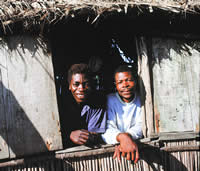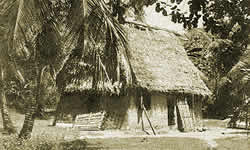Garifuna
The Garifuna Community
Welcome to the Garifuna World! You are about to experience the origin of the Garifuna
community, their incorporating process to society, their resistance to
English and French Colonization and their deporting to Honduran land.
 The Garifuna society, also known as the Black Caribs,
was first originated in XVII in San Vicente, about a century after the
conquering of Central America, South America, and the lower Antilles.
The conquerors were not interested in San Vicente and Dominica at first
because of its topographic features, lack of precious metals and grasslands
for cattle raising, but the Caribs did become interested because of its
magnificent areas for fishing. The Garifuna society, also known as the Black Caribs,
was first originated in XVII in San Vicente, about a century after the
conquering of Central America, South America, and the lower Antilles.
The conquerors were not interested in San Vicente and Dominica at first
because of its topographic features, lack of precious metals and grasslands
for cattle raising, but the Caribs did become interested because of its
magnificent areas for fishing.
Who were the Caribs? The Caribs were strong, robust men,
of small stature, and mongoloid physical features. They had long, black,
straight and thick hair, perfectly cut to their forehead and were generally
dressed in a colorful christening skirt. Their original name was Callinagu
and their place of origin was from the Orinoco Delta, which they abandoned
for conquering the Lower Antilles. When they arrived to the Lower Antilles,
they exterminated the Arahuaco men, but decided to keep the women for
their convenience. The union of these two Indian groups gave origin to
a new society called the Caliponan (also known as the Yellow Caribs, Red
Caribs, and Amerindians).
Formation of the Garifuna Society
 The
beginning of the formation process was in 1635, and believed to have been
caused by the sinking of two Spanish ships loaded with black slaves who
were being delivered to their buyers. In those days it was common for
the Caliponan to give misleading directions, which lead them to the riverbanks
where they disposed the ships from their shipments (gold, wine, and slaves)
and killed all of the crewmembers. The
beginning of the formation process was in 1635, and believed to have been
caused by the sinking of two Spanish ships loaded with black slaves who
were being delivered to their buyers. In those days it was common for
the Caliponan to give misleading directions, which lead them to the riverbanks
where they disposed the ships from their shipments (gold, wine, and slaves)
and killed all of the crewmembers.
The Africans were anxious to establish friend links to avoid being sent
back to their owners as slaves; therefore they soon adopted their customs
and native garifuna language. Shortly after, they married the Caliponan women who
gave birth to a whole new kind of siblings. Their descendents preserved
the height and skin color of their father, who on the contrary of the
Caliponan were tall and corpulent. This new society (Garifuna) centered
their family life in the sexual division of work as a base for their economic
activities.
Shortly after came the conquering of Barbados and Santa Lucia, and men,
who could not accept the new rulers, accumulated goods and emigrated in
canoes towards San Vicente (28 miles from Barbados). These men, along
with the Caliponan, then became such powerful allies in their war against
conquerors, that they were considered an allied and independent group.
|
|
In the XVII century, a drastic change occurred in the Vicentinian society.
The black society had become the dominant group due to their geometric
growth because of the immigration of refugees. The constant fighting for
power and territorial disputes soon divided both sides. Garifunas forced
the Caliponan to move to the Western part and they move to the Northwestern
part of the island. Both groups tried to resolve their personal difficulties,
because they were aware that an internal division would drive the conqueror's
attention to them.
When news about their differences arrived to France, the French took
part in this division by supporting the Caliponan. They soon inhabited
Caliponan land, while Garifunas defended their land from any European
colonization. The French made many intents, but they soon were convinced
they had to stop interfering and had to maintain peace links with Garifunas.
Garifunas acquired the French taste for wine instead of rum, dominated
French language, incorporated French words to their dialect, adopted the
French currency as a mean for commercial trading, obtained French names
and customs, and eventually became their allies against the English colonization. >>
Top
French and English Interference
The three coming decades, 1730-1762, were characterized by the constant
disputes between France and Great Britain for the desire of gaining power
over San Vicente, Dominica, and Santa Lucia. The occurrence of these acts
can be described as follows:
|
1730: San Vicente, Dominica, and Santa Lucia are declared to be free
from European inheritance.
1742: British colony is established in Rattan (Roatan).
1748: Aix-La Chapelle Treaty is signed in which San Vicente, Dominica,
and Tobago are declared of exclusive possession of the Caliponan natives.
1750: Peace Treaty signed between Spain and Great Britain.
1756: War between France and England begins.
1759: English attack Martinica, and take over Guadalupe Island.
1761: English take over Dominica.
1762: Martinica is taken over by the English (February 4th). In that same
date Granada, Tobago, San Vicente, and Santa Lucia were ceded to Great
Britain.
1763: Paris Peace Treaty is signed. San Vicente, Grenada, and Dominica
were ceded to Great Britain; Cuba was given to Spain; Guadalupe, Martinica,
and Santa Lucia were ceded to France.
Great Britain then declared war against the French; the disputing possessions
were Martinica, and Santa Lucia. These acts of treason infuriated the
French, who in reprisal, responded by exporting their revolutionary ideals
to the Caribbean Islands in possession of the English. However, Garifunas
understood that these philanthropic manifestations were not to be taken
seriously, because most French wanted desired that Garifuna and English
would destroy each other and consequently be force to leave the island.
Therefore, Garifunas demanded sufficient warlike material from the French
as a guarantee of their noble intentions. >>
Top
The War of Exile
First Phase: the Garifunas led by Du Valleé were such a powerful
group that they constantly defeated the English. This group gained power
over Kingstown, Dorset shire Hill, and another group lead by Chatolier
gained power over Chateaubelair. Both groups soon joined forces, along
with men that they ha collected in their way, and became such a powerful
group that many feared them.
Soon came the death of Chatolier, who was convinced of his paranormal
powers and invincibility, who made the fatal mistake of asking Alexander
Leith (English) to a duel that caused his death. Chatolier`s death evidently
confused the Garifuna-French alliance who held the fighting back and carefully
awaited for the next step.
Second Phase: In this stage, the hostility lasted a little more than
a year, and was characterized for being a war of exhaustion. Set before
the numerous losses of seven months of fighting, and finding no solution
to solve their differences, the English governor accompanied by the military
force of 4,000 men decided to attack the Garifuna-French alliance. Faced
upon the military power force upon them, the Garifuna determined that
it was convenient to stop the war and finally surrendered.
Garifuna Expatriation
The English began to worry about their future in the island in comparison
to the unexpected number of Garifunas living in their new territory. Therefore,
the search for new land where the Garifuna could settle began.
Finally in February 20th, 1797, a total of 2,248 Garifunas along with
stored food supplies were set aboard ships and then headed toward the
Honduran Coast and Bay Islands. In April 12th, 1797, the Garifunas first
set foot in Honduran territory.
Although the English left them with enough food supplies, utensils, fishing
chords, and seeds for planting, it became a little difficult to clean
the terrain and to plant before the rainy season began.
Garifunas then asked the Spanish to take them to the Honduran Coast.
The Spanish accepted gracefully because they knew, that by doing this,
they would now own the Bay Islands, and they would also acquire an additional
labor force. The Spanish kept their promise; Garifunas arrived in Trujillo, Colon (Honduras) on May 17th, 1797.
In the early 1900s more then 100 enterprises had been exporting bananas
from the Central American coast and Garifunas were involved in this commercial
trading by helping these companies with the sowing and loading of banana.
These companies soon extended their trading circle along the coast f Honduras
and concentrated their fruit shipping along Punta Castilla (Trujillo),
Tela, La Ceiba, and Cortés in Honduras; and in Livingston and Puerto
Barrios in Guatemala, and finally in Belize City. Garifunas mostly concentrated
in nearby towns because working for these companies had become a good
source of income. However, in the 1940s some of these companies were shut
down because their banana plantations had been greatly affected by plagues;
this caused the unemployment of many Garifunas. Garifunas then got involved
in the seafaring business where they immigrated to other parts of Central
and North America. >> Top
Garifuna Society Today
 Culture:
Their social and cultural characteristics are manifested in their archaic
family and social structures, which have suffered very little changes.
They still share their dialect, circular dances, religious practices,
Punta dance, tales, banana cultivation, and rooster and pig sacrifices
with the indigenous people of the Amazon. Culture:
Their social and cultural characteristics are manifested in their archaic
family and social structures, which have suffered very little changes.
They still share their dialect, circular dances, religious practices,
Punta dance, tales, banana cultivation, and rooster and pig sacrifices
with the indigenous people of the Amazon.
Their ways of production are still based in subsistence farming. Among
the different communities there is a great potential of production, and
in most cases the land is very fertile for farming, however the only people
involved are the elders because young people believe farming is not a
great source of income. Youngsters are mostly dedicated to fishing, because
most of the fish are set for sale and produce an immediate source of income.
Youngsters show little or no interest in participating in social reunions
with the rest of their community; elders and the women are usually the
ones who interact with these reunions. It can be concluded that young
Garifunas seem to be more interested in immigrating to North America.
Location: The Garifuna population that lives in the Atlantic Coast,
between Belize and Nicaragua, is distributed in 43 towns and villages.
Approximately 98,000 Garifunas live in Honduras, and they are mostly concentrated
along the North coast from Masca, Cortés to Plaplaya, Gracias a
Dios. Among other villages are: Santa Rosa de Aguan, Tornabé, Limón,
Nueva Armenia, San Juán, Cosuna, Triunfo de la Cruz, and Baja Mar.
Health: Garifuna are subject to poor sanitary conditions throughout
most of the area. The lack of clinical establishments, basic infrastructure
projects, illness prevention programs, and nutrition programs greatly
affect Garifunas. We can conclude that about 78% of the children under
12 years of age suffer from malnutrition, and that 3 out of 10 will die
before they are 2 years old.
Housing: their housing consist of small huts with walls made of
royal palm, sugar cane and of cement blocks. The ceiling is commonly made
of hay, however they also use zinc as a ceiling too. There is a great
tendency to replace their traditional style of housing for more modern
types; however, these changes have helped improve their health conditions.
Politics: Garifunas do not believe in politics, they believe that
they are too peaceful and that they can handle their personal problems
without the intervention of any legal force; however, in some areas a
governor is in charge of providing justice between the people. Only Garifunas
that had the opportunity of being well educated are the ones that occupy
government positions today.
Language: Most Garifunas not only speak Spanish, but also use the
Igñeri dialect that is a combination of Arahuaco, French, Swahili,
and Bantu.
Religion: Garifunas still maintain their
own religious system that is a mixture of African and Amerindian traditions
to which they have incorporated Catholic elements. Of great importance
is the Garifuna religious system called Gubida that is the conception
of the dreams and possession rituals as altered states of conscience considered,
by the participants and believers, to be caused by the possession of a
spiritual entity.
Education: 72% of the population is illiterate
or semi-illiterate. Not enough schools are provided for them in he nearby
areas; and villages that have schools, only have teachers to provide them
with enough education to reach a 3rd grade level and sometimes a 6th grade
level if they are lucky. Only 10% of the Garifunas who finish elementary
school continue with their studies, another percentage immigrates to the
United States, and the rest just integrate their community life and eventually
become illiterates again because of the lack of practice. >>
Top
| Organizations in Representation
of Garifunas
· ONECA (Organizacion Negra Centroamericana/Central American Black Organization). The largest umbrella organization for Black communities in Central America and the Caribbean. President: Celeo Alvarez Casildo
· ODECO (Organización de Desarrollo Étnico
Comunitario)
Objectives:
1. Development of Local Capacities.
2. Incidence and Empowerment of Afro-Honduran population.
3. Institutional Development, Fortification, and Efficiency.
Its Directive Board is composed of 15 members, nominated as follows:
President: Celio Álvarez Cabildo Secretary: Zulma Valencia
Vice-President: Luis Francisco Green Technical Affairs: Onelia Colon
Public Prosecutor: Bernard Martinez Discipline Affairs: Robustiana Castro
Secretary of Education: Delsy Alvarez Children Affairs: Gregorio Jimenez
Secretary of Promotion: Galata Arzú Secretary of Youth: Karen Bargas
Secretary of Cultural Affairs: Laura Alvarez Secretary of Sports: Candida
Blanco
Secretary of Feminine Affairs: Miriam Tifet Treasurer: Felicia Lacayo
Legal and Human Rights Department: Norman A. Jimenez
Address: Bo. Potreritos, Avenida Júnior, ½ cuadra debajo
de Escuela Copan Galel
La Ceiba Atlántida, Honduras, C.A.
Phone No.: (504) 2443-3651 Fax No.: (504) 2443-4642
(504) 2440-2498
Email: odeco.hn @ gmail.com
>> Top
· OFRANEH: (Organización
Fraternal Negra Hondureña).
Objectives:
1. Provide help to Garifuna Society.
2. Provide defense of Garifuna territory.
3. Defense of Garifuna's culture
Directive Board
General Coordinator: Gregoria Flores
Coordination Assistant: Miriam Miranda
Act Coordinator: Ana Lucy Bengoechea
Legal Affairs: Teófilo Lacayo
E-mail: ofraneh@laceiba.com
Website: http://www.ofraneh.org/ofraneh/index.html
Address: Bo. Independencia, esquina opuesta Escuela Luis Landa.
La Ceiba, Atlántida, Honduras, C. A.
Phone No. : (504)-443-2492
>> Top
|
|
|

